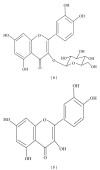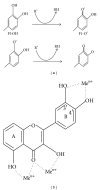Chemistry and biological activities of flavonoids: an overview
- PMID: 24470791
- PMCID: PMC3891543
- DOI: 10.1155/2013/162750
Chemistry and biological activities of flavonoids: an overview
Abstract
There has been increasing interest in the research on flavonoids from plant sources because of their versatile health benefits reported in various epidemiological studies. Since flavonoids are directly associated with human dietary ingredients and health, there is need to evaluate structure and function relationship. The bioavailability, metabolism, and biological activity of flavonoids depend upon the configuration, total number of hydroxyl groups, and substitution of functional groups about their nuclear structure. Fruits and vegetables are the main dietary sources of flavonoids for humans, along with tea and wine. Most recent researches have focused on the health aspects of flavonoids for humans. Many flavonoids are shown to have antioxidative activity, free radical scavenging capacity, coronary heart disease prevention, hepatoprotective, anti-inflammatory, and anticancer activities, while some flavonoids exhibit potential antiviral activities. In plant systems, flavonoids help in combating oxidative stress and act as growth regulators. For pharmaceutical purposes cost-effective bulk production of different types of flavonoids has been made possible with the help of microbial biotechnology. This review highlights the structural features of flavonoids, their beneficial roles in human health, and significance in plants as well as their microbial production.
Figures




Similar articles
-
A Compressive Review on Source, Toxicity and Biological Activity of Flavonoid.Curr Top Med Chem. 2024;24(24):2093-2116. doi: 10.2174/0115680266316032240718050055. Curr Top Med Chem. 2024. PMID: 39108008 Review.
-
[Advances in the structure-activity relationship study of natural flavonoids and its derivatives].Yao Xue Xue Bao. 2011 Jun;46(6):622-30. Yao Xue Xue Bao. 2011. PMID: 21882520 Review. Chinese.
-
Flavonoids in food and their health benefits.Plant Foods Hum Nutr. 2004 Summer;59(3):113-22. doi: 10.1007/s11130-004-0049-7. Plant Foods Hum Nutr. 2004. PMID: 15678717 Review.
-
Distribution and biological activities of the flavonoid luteolin.Mini Rev Med Chem. 2009 Jan;9(1):31-59. doi: 10.2174/138955709787001712. Mini Rev Med Chem. 2009. PMID: 19149659 Review.
-
Important Flavonoids and Their Role as a Therapeutic Agent.Molecules. 2020 Nov 11;25(22):5243. doi: 10.3390/molecules25225243. Molecules. 2020. PMID: 33187049 Free PMC article. Review.
Cited by
-
Effects of a novel polyphenol-rich plant extract on body composition, inflammation, insulin sensitivity, and glucose homeostasis in obese mice.Int J Obes (Lond). 2021 Sep;45(9):2016-2027. doi: 10.1038/s41366-021-00870-x. Epub 2021 Jun 2. Int J Obes (Lond). 2021. PMID: 34079069
-
Potential Utilisation of Theobroma cacao Pod Husk Extract: Protective Capability Evaluation Against Pollution Models and Formulation into Niosomes.Trop Life Sci Res. 2024 Jul;35(2):107-140. doi: 10.21315/tlsr2024.35.2.6. Epub 2024 Jul 31. Trop Life Sci Res. 2024. PMID: 39234471 Free PMC article.
-
Biosynthesis and Pharmacological Activities of the Bioactive Compounds of White Mulberry (Morus alba): Current Paradigms and Future Challenges.Biology (Basel). 2024 Jul 7;13(7):506. doi: 10.3390/biology13070506. Biology (Basel). 2024. PMID: 39056699 Free PMC article. Review.
-
Identification of a polyphenol O-methyltransferase with broad substrate flexibility in Streptomyces albidoflavus J1074.Microb Cell Fact. 2024 Oct 5;23(1):265. doi: 10.1186/s12934-024-02541-8. Microb Cell Fact. 2024. PMID: 39369216 Free PMC article.
-
Extraction of Honey Polyphenols: Method Development and Evidence of Cis Isomerization.Anal Chem Insights. 2016 Aug 10;11:49-57. doi: 10.4137/ACI.S39739. eCollection 2016. Anal Chem Insights. 2016. PMID: 27547032 Free PMC article.
References
-
- Mahomoodally MF, Gurib-Fakim A, Subratty AH. Antimicrobial activities and phytochemical profiles of endemic medicinal plants of Mauritius. Pharmaceutical Biology. 2005;43(3):237–242.
-
- Pandey AK. Anti-staphylococcal activity of a pan-tropical aggressive and obnoxious weed Parihenium histerophorus: an in vitro study. National Academy Science Letters. 2007;30(11-12):383–386.
-
- Dixon RA, Dey PM, Lamb CJ. Phytoalexins: enzymology and molecular biology. Advances in Enzymology and Related Areas of Molecular Biology. 1983;55:1–136. - PubMed
-
- Kelly EH, Anthony RT, Dennis JB. Flavonoid antioxidants: chemistry, metabolism and structure-activity relationships. Journal of Nutritional Biochemistry. 2002;13(10):572–584. - PubMed
Publication types
MeSH terms
Substances
LinkOut - more resources
Full Text Sources
Other Literature Sources

